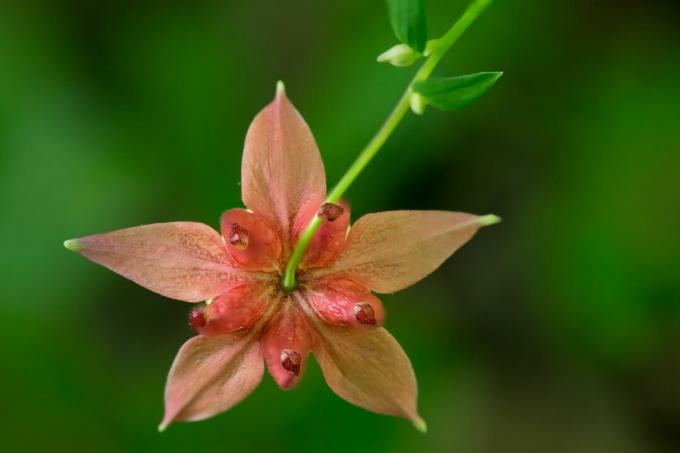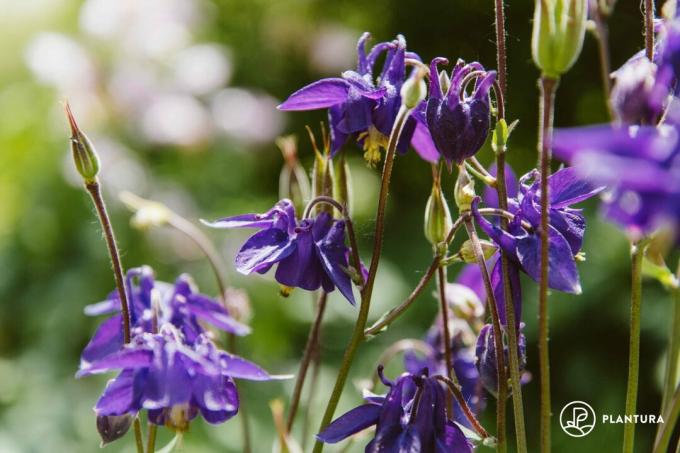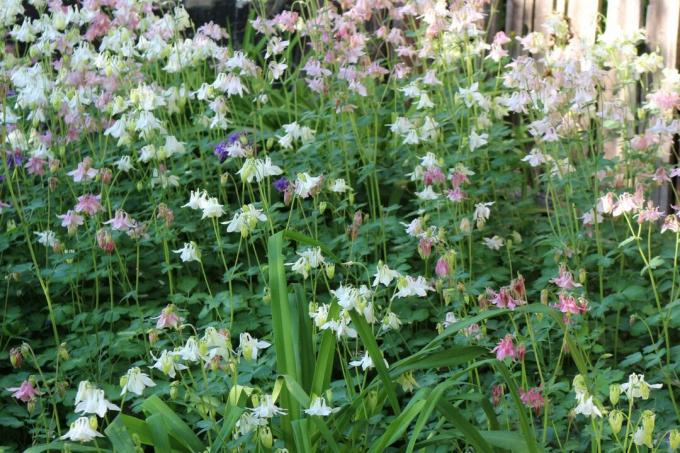The flower with the unusual flower shape is available in many variants. Here you will find the most important information about sowing and caring for columbines.

A very special perennial species is the Columbine (aquilegia). With their extravagant flowers in strong purple to a delicate pink, they transform many a garden into a sea of flowers and are also particularly easy to care for.
contents
- Columbine: origin and properties
- Columbine species and varieties
- buy columbine
-
plant columbines
- The perfect location for the Columbine
- Procedure for sowing columbines
-
maintain columbine
- Water columbine properly
- Cut columbine correctly
- Fertilize columbines properly
- Is columbine poisonous?
Columbines were planted in European gardens as early as the late Middle Ages and the plant is now an integral part of numerous monastery or cottage gardens. But the columbine has also found its way into many ornamental gardens - and rightly so.
Columbine: origin and properties
Although the flowers of the columbine look rather complicated with their spurs and nests, the plant is one of the simply built plants. It is a very original and old flowering plant and even if you probably know it primarily from the garden, there are columbines as a wild form even here in Germany. The Common Columbine (Aquilegia vulgaris) likes to inhabit semi-shady deciduous forests, forest edges and even mountain meadows. But the plants are not only native to Europe, because they can be found throughout the northern hemisphere. The differences between the flowers are fascinating. While Eurasian columbines have more blue to lilac colored flowers bumblebees and bees to attract, North American species with their white, yellow, and red tones specialize in hawk moths and hummingbirds as pollinators. The heyday of the aquilegia in Germany is between May and July.

Aquilegia can be identified quite easily in Asia and North America as well as in Europe. While the flowers attract attention with their spurs, the leaves are long-stalked and arranged in a rosette shape. The tripartite leaves are characteristically notched. The plants can reach an age of four to five years.
Columbine species and varieties
Due to the large spread over the entire northern hemisphere and their long-standing cultivation, columbines have developed a large variety of species and varieties. There are now said to be over 70 species and many more varieties. The species are quite closely related and can sometimes interbreed, resulting in hybrids. Of course, this makes it much more difficult to distinguish between the individual species. However, Eurasian and North American species have now become genetically more distant from each other. Unfortunately, cultivated forms from gardens often hybridize with wild columbines, which has already changed the original wild forms in Europe.

The following varieties of columbine are particularly beautiful:
- A vulgaris 'wild form': This columbine is not only called wild form, it is also. It is the archetype of all varieties of Aquilegia vulgaris and flowers classic in soft pink to deep purple.
- A vulgaris 'William Guinness': This variety in noble Bordeaux to purple colors is colored white only at the tips of the petals. The white color forms an exciting contrast to the otherwise deep dark flower.
- A vulgaris 'Nora Barlow': The variety 'Nora Barlow' is characterized by its double flowers. The white flower tips stand out clearly from the pink flower. The strain's name comes from its discoverer, Nora Barlow.
- A caerulea 'Jewel White': The cultivar of the American Columbine species Aquilegia cearulea shines in pure white.
- A caerulea 'Blue Star': These Aquilegia caerulea-Hybrid is characterized by the white petals that contrast with the otherwise blue flower.

buy columbine
There is a wide variety of columbines on offer in the trade, mostly they are offered as seed packs. A wide variety of species from both North America and Eurasia are available. They are available as 80 centimeter high perennials, but also in dwarf form. The flowers can be double or double, one color or even two colors. In addition to the various aquilegiaspecies there are still the two close relatives from Asia, false aquilegia (semiaquilegia) and the dwarf columbines (paraquilegia).
More about Purchase of Columbines we have prepared for you here.
plant columbines
Basically, planting columbines is not a masterpiece. As with most plants, you should preferably plant your columbine in the spring so that it takes root sufficiently over the summer. So it can survive the winter unscathed. To plant, you should dig a hole deep enough, loosen the columbine's root ball to make it easier for them to grow, and then place them in the hole. The rest of the hole is filled with soil. Now press the columbine a little to ensure its stability. Don't forget to water - and the planting is done.

The perfect location for the Columbine
Columbines grow mainly in sparse forests and at the edges of forests. For this reason, they prefer a semi-shady location. However, sun does not usually do any harm either, especially since some species also grow in meadows. In particular, many American species even prefer to be in direct sun than in the shade. Forest soil is mostly fresh and humus and the columbine usually likes it that way. The location should therefore provide good soil and not be too dry.
Procedure for sowing columbines
Once the columbines are in the garden, they quickly spread through their numerous seeds. Cultivation from seeds is correspondingly uncomplicated. You can sow either in autumn or in early spring between February and May. The seeds of some columbine species need a cold stimulus to germinate. It is therefore better to sow seeds of these species in autumn or February.
The sowing itself also works directly in the garden, but sowing in a seed tray is safer. In this case, you can put the seeds in the fridge for a few days to encourage them to germinate. Either way, the seeds should be kept moist after sowing. In order not to wash away small seeds, you can use a water sprayer.

maintain columbine
Columbines are also native to Germany. For this reason, after planting and initial watering, they don't actually need any more care. In the right place, they can manage all by themselves, after all, they have to do that in the wild too.
Water columbine properly
Naturally, columbines are more likely to be found in fresh locations such as in forests and mountain meadows. Accordingly, most Columbine species require sufficient water. Normally, the rain is enough for this, watering may only be necessary in extremely dry summers. Of course, plants that grow on very sandy substrate or in a very dry location also need water from time to time when it gets too dry.

Cut columbine correctly
Actually, columbines do not need pruning, they thrive wonderfully without them. So why bother then? After flowering, columbines produce an incredible amount of small seeds. So if you like columbines but don't want them everywhere in the garden, you should remove the infructescence after flowering. Cut off the stems of the maturing infructescences at the bottom. But don't wait too long before pruning, as seed development can be rapid.
Fertilize columbines properly
As already mentioned, fertilization is not necessary in principle. A planted columbine gets along quite well with the nutrients present in the substrate. The situation is different for potted plants that need fertilizer regularly. This is where a fertilizer with an organic long-term effect like ours comes in handy Plantura organic universal fertilizer at. This can also be applied to columbines growing in the bed in spring at the beginning of the growing season to give the plant an optimal start. Alternatively is also compost or horse manure suitable for supporting fertilization.
Is columbine poisonous?
In the Middle Ages, the columbine was not only kept as an ornamental plant, its leaves were also used to treat fever. as medicinal plants Plants used usually contain substances that are healing in small doses, but toxic in high doses - including columbine. Their consumption can cause various unsightly symptoms, but these also subside quickly.
More about the ingredients of columbine and its effect can be found here.
